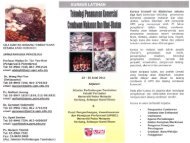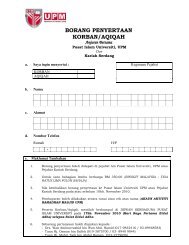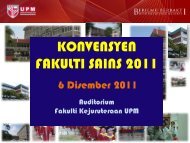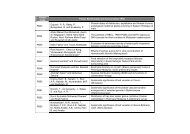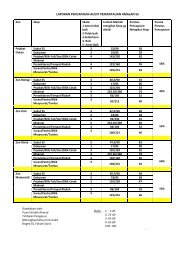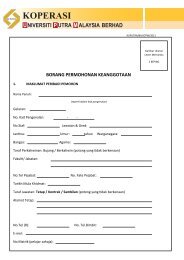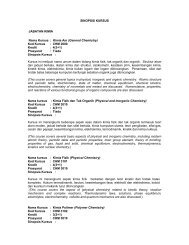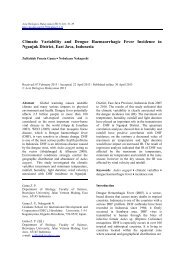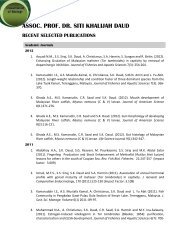Programme Book - UPM - Universiti Putra Malaysia
Programme Book - UPM - Universiti Putra Malaysia
Programme Book - UPM - Universiti Putra Malaysia
Create successful ePaper yourself
Turn your PDF publications into a flip-book with our unique Google optimized e-Paper software.
P23 SYNTHESIS AND CHARACTERISATION OF GLASSPOLYALKENOATE CEMENT USING Anadara Granosa SHELLSH. J. Ong, N. Zainuddin*, V. W. Francis ThooDepartment of Chemistry, Faculty of Science, <strong>Universiti</strong> <strong>Putra</strong> <strong>Malaysia</strong>, 43400 <strong>UPM</strong>Serdang, Selangor, <strong>Malaysia</strong>Corresponding author: hazlin@science.upm.edu.myGlass polyalkenoate cements (GPCs) are produced via acid-base reaction betweencalcium- fluoroaluminosilicate glass powders and freeze- dried polyacrylic acid(PAA) powders. Anadara granosa shells (cockle shells), which mainly constituted byCaCO 3 , have been utilized in this study as CaO source for being a part of glasscomponents in GPC. Cockle shells preparation, glass synthesis, cement productionand characterizations were four main procedures involved. CaCO 3 or cockle shellswere mixed with SiO 2 , Al 2 O 3 , CaF 2 and P 2 O 5 and heated at 1500 °C for 2 hours. Twoglass types were produced via melt-quench route, GWX 1 and GFS 1, which wereformed from analytical grade CaCO 3 and cockle shells respectively. GPCs wereproduced by introducing distilled water into the pre-mixed glass and PAA powders inpowder to liquid ratio of 4:1 by weight. Thermogravimetric analysis (TGA), X-raydiffraction (XRD), Fourier- Transform Infrared Spectroscopy (FT-IR) andcompressive strength evaluation were employed for characterizations. 98.68% ofCaCO 3 was present in the cockle shells based on TGA analysis. This suggested cockleshells is an ideal natural source rich in CaCO 3 suitable to provide CaO. The absenceof sharp peaks observed in XRD pattern suggested that both GWX 1 and GFS 1glasses, were completely amorphous. FT-IR results showed that acid-base reactionoccurred in both GWX 1 and GFS 1 as indicated by conversions of carboxylic acid, -COOH into metal polyacrylate (salt) and hydrated silica gel, SiOH into silica gellayer, Si-O-Si respectively. It was found that setting reaction in GPCFS was slowerthan GPCWX at 30 minutes setting. In addition, GPCFS exhibited relatively lowercompressive strength at 1 day, by the difference of 25.30 MPa. This was because Na +present in cockles shells had competed with metal cations for carboxylate groups ofPAA, thus inhibited cross-linking process during setting reaction. Besides, it wasobservable that FT-IR spectra for both GPCWX and GPCFS showed insignificantchange for peak intensities of COOH and salt after 1 day setting. This suggested thatboth glass types had completely set after 1 day, which was also supported byinsignificant increment of compressive strength values for both GPCWX and GPCFSafter 1 day. In conclusion, Anadara granosa shells can be potentially utilized for theglass synthesis in GPC production as GPCFS eventually exhibited similar settingproperties and compressive strength as GPCWX.38 |16 th Industrial Chemistry Seminar: Chemistry- A Passport to a Brighter Future




